7 Minute Read
Diamond Carat Guide
When selecting your perfect diamond engagement ring, the first thing that often springs to mind is the size of the stone – but bigger isn’t always better, and with many different factors to consider, finding the size and quality that’s perfect for your partner can be difficult, especially when keeping your budget in mind too.
The term ‘carat’ is one you may be familiar with; a high carat diamond ring is often associated with opulence, luxury and extravagance. But what does this term actually mean? How important is the carat value of your diamond? And how do you know what carat value to choose? These are just some of the questions we’ll answer for you in our complete guide to diamond carat.
What Is Diamond Carat Weight?
Diamonds are measured in carats, which refers to the weight of the diamond. The larger the carat, the heavier the diamond will be. Outsized carat weights are more rare, and therefore precious.
Carats are split into points: 100 points = one carat
It is important to remember that the weight of a diamond is different to its size – a diamond may appear bigger, but weigh less. A diamond’s weight in relation to its size can determine how valuable or desirable a diamond is and different shapes of diamond can visually impact this. If you are looking at cluster rings or pieces with more than one diamond, the stones are weighted together rather than individually.
ⓘ Need to know:
Diamond carats are different to gold carats. Gold carats are a measurement of the purity of gold as opposed to the weight.
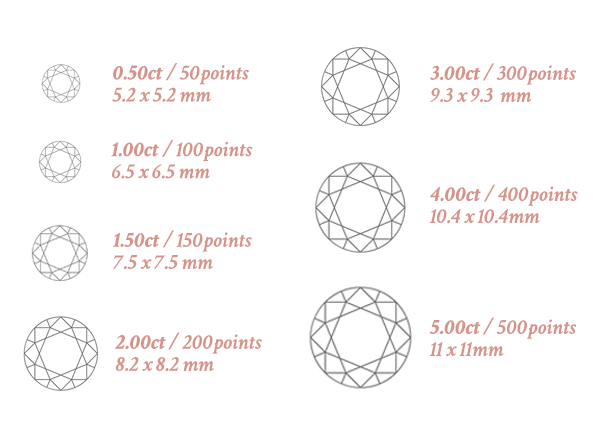
How Important Is Diamond Carat?
There is a common misconception that the larger the carat value, the better the diamond. There are a range of factors that play into the quality of a diamond, and whilst a large stone can be somewhat of a status symbol, it is not necessarily a true reflection of quality, sparkle or in fact price.
For example, a one-carat stone can greatly vary in price and quality when all of their other features/factors/C’s are taken into consideration. Diamond features are usually highlighted in a diamond certificate. Here’s an example of why it’s important to take all diamond quality factors into account:
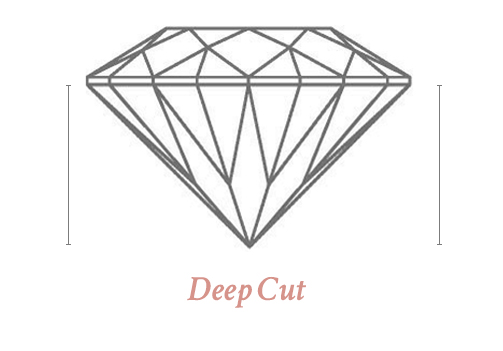
Deep Cut
Deeper cut diamonds with a lot of height on the lower portion of the diamond can be undesirable due to a large amount of the carat weight being hidden from view under the setting.
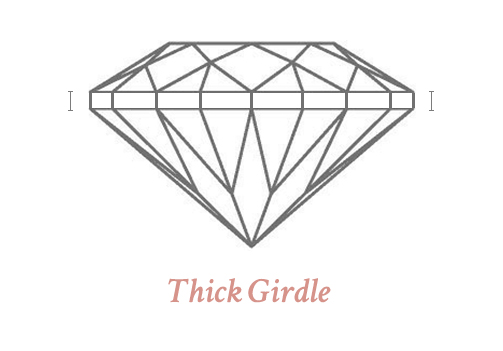
Thick Girdle
A thick girdle around a diamond is noticeable above a ring setting and it does harbour some carat weight. A thick girdle also reduces sparkle and creates dull or dark areas when looking into a diamond.
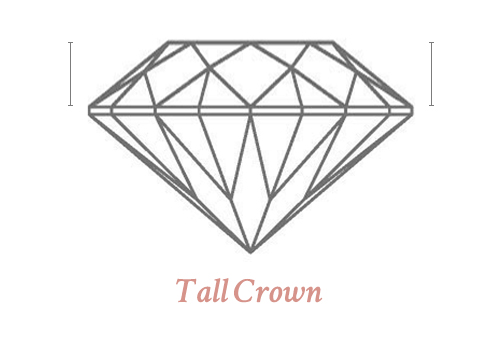
Elongated Crown
A tall crown height gives a similar problem to a deep cut diamond in that the height isn't often noticed when looking at a diamond initially despite being more costly however, a tall crown will be seen above the setting.
Choosing a Carat Weight
There are many factors you should consider when choosing a diamond, including:
- Cut
- Colour
- Clarity
- Shape
- Certification
Taking the value of your diamond per carat into consideration is an important part of choosing the right diamond for you. For example, two diamonds of the same carat weight can differ drastically in value once these other factors are also taken into account.
When choosing your diamond, consider both the cut and carat together – a larger carat diamond with a poor cut grade can look smaller than a diamond of the same size with a higher cut grade. Where possible, choose the highest cut grade with the widest measurements to get a larger diamond surface area.
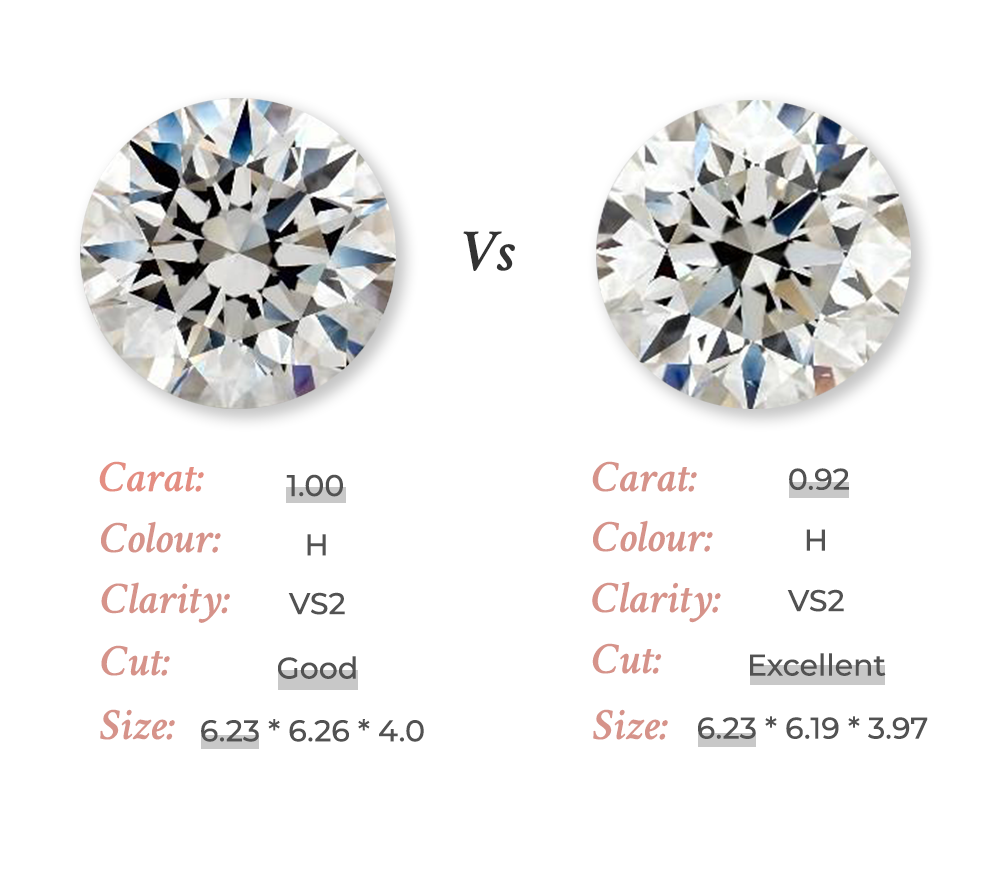
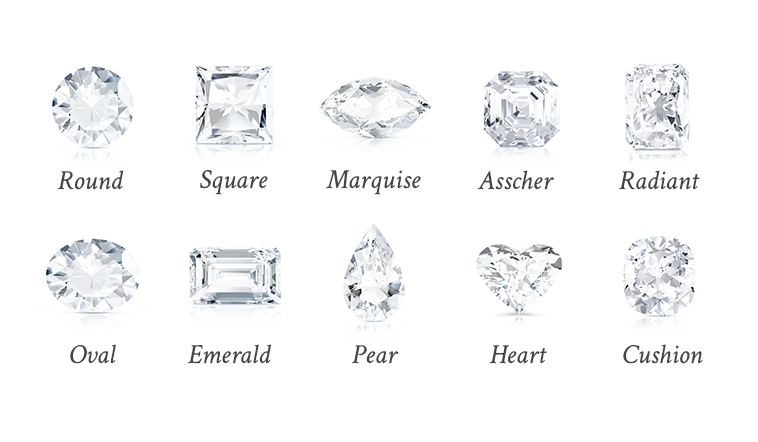
Carat & Diamond Shape
Carat size in combination with the shape, colour and cut of the stone can play a large part in determining how big the diamond appears, for example, a long marquise diamond may appear larger than a round diamond, even if they share the same carat weight. When comparing two diamonds of the same shape, consider cut grades and depth percentages. Shallower stones often appear larger than deep ones.
When selecting your diamond, prioritise these factors in order:
- Cut quality
- Colour grade
- Carat
Another factor to keep in mind is how the ring will look on the wearer. On smaller fingers, diamonds will appear larger, so adjusting your carat weight and cut to suit this is important and can provide more budget for other factors such as a higher grade of clarity or colour.
EXPERT TIP:
A common misconception is that half a carat is half the size of one carat. In actual fact, a half carat is half the weight of one carat and the difference in mm size on a round stone is only 1.5mm.
In other words, it's possible for a half-carat diamond to appear almost as large as a full carat. A good tip to get the best price is to shop for stones that fall just ‘shy’ of popular carat weights like 1ct or 2.5ct. Instead try: 0.99ct or 2.48ct stones
Diamond Carats and Price
When it comes to carats and price, the general principle is that the heavier the diamond, the higher the price, due to the scarcity of large diamond crystals. However, it is worth remembering that prices aren’t steady – a 1 carat diamond may cost more than two 0.50 carat diamonds of the same quality.
Depending on the other factors you choose (such as colour, cut quality etc.) you can usually expect to pay around £6,000 – £10,000 for a one-carat diamond with optimum grades, and a decent quality great value one-carat diamond often costs around £6,000 - £7,200. You can get one-carat diamonds for as low as £4,000 but be wary of these, as this will often come with a compromise in terms of the diamond’s other qualities.
Usually, doubling the weight of your diamond can cause an increase in cost of about 3-4 times more, and highly sought-after sizes can come with a price premium; nevertheless, there are still some things you can do to get a beautiful diamond that’s still within budget.
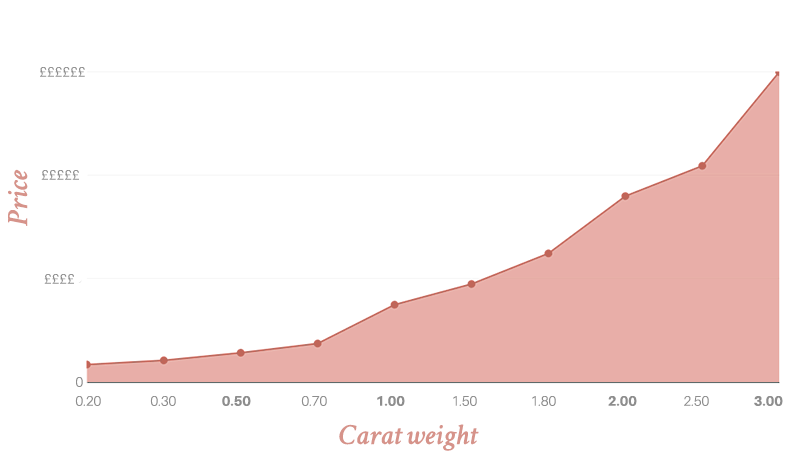
Our Top Tips
- Invest in the best quality cut and colour you can get, before you consider carat value–the best value and highest quality diamond you can purchase will be a balance of all these factors, so remember not to base your decision solely on the weight of the diamond (carat), which may not be as obviously distinguishable to the naked eye as the colour or cut of the stone
- Save money by choosing a carat weight slightly below the whole and half-carat standard weights– the slight difference will never be noticed and you can save a lot of money this way
- Fancy shapes are better value per carat–Fancy-shaped diamonds cost less per carat than a round diamond, so you can maximise the appearance of a diamond by choosing a fancy shape that appears larger than their actual carat size. If you decide to opt for a fancy shape, select a halo setting to maximise this further
- Buy for your partner, not for prestige –If you’re choosing a diamond for someone else, think about what shape, colour and weight would best compliment their fingers. Different rings look different on different people so always aim to buy with your partner in mind, rather than selecting the biggest, flashiest stone you can manage
- Remember that a diamond’s carat value is a measurement of its weight, not its size–Whilst there is an obvious link between these two, it is possible to get diamonds with a large surface area but a low carat value and vice versa, so be clear about your purchase before you make it.
Still need help?
If you need any further assistance and guidance with diamond clarity, our jewellery experts are here to help! Visit us in store or call us to arrange an appointment so we can provide the guidance you need. You can also send a message via zendesk in the bottom right of your screen.
Libby Johnson
Director, Johnsons Jewellers




